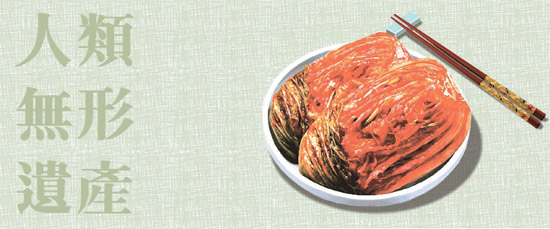Making of kimchi as rich as sharing it

The October verse of the poem by Jeong Hak-yu (1786-1855) titled “Farmers Songs by the Month” suggests that making kimchi was already a widespread practice in the 19th century. Peppers and pepper powder were added to kimchi after the 1800s. According to historic documents, kimchi was mostly salt-pickled or vinegar-marinated in the 17th and 18th centuries. In order to add color, red pigments from cockscomb flowers were used.
Did Jeong, the late Joseon-period scholar and second son of Jeong Yak-yong, make kimchi himself and write the poem? While he farmed in Yangju, Gyeonggi, it is likely that he had women and servants make the traditional pickles. Nevertheless, it is still quite pleasant to imagine the Confucian scholar of the patriarchal period observing farming practices and traditions and writing about them.
Recently, my wife’s family made kimchi together at her sister’s house. I didn’t exactly make kimchi myself. I was more of an observer. Four sisters and their husbands got together, but the men didn’t offer much help. In the old times, we could have dug a pit to bury the kimchi jars. But all we could do was move heavy jars and pass out the seasoning. Making kimchi with 90 heads of cabbage and other varieties took two days. Fortunately, my sister-in-law lives in a house with a yard. It would be nearly impossible to make so much kimchi in an apartment. In the early morning, cabbages and radishes were immersed in salt water and turned upside-down twice. While the vegetables were being pickled, spices were prepared and garlics and scallions were cut. I had no idea live shrimps were so expensive. I felt very content when I returned home with several containers filled with all kinds of freshly-made kimchi.
In the eighth Unesco Intergovernmental Committee for the Safeguarding of the Intangible Cultural Heritage, “kimjang,” the practice of making kimchi in bulk around the early winter, has been recognized as an Intangible Cultural Heritage of Humanity. The spirit in “The Farmers’ Songs by the Month” has gained international recognition. Unesco has highly regarded the culture of “making and sharing kimchi.” The pickled vegetable itself is a delicacy, but the tradition of working together as a community and sharing the outcome is especially a valuable heritage of humanity. How far have we come? I was reminded of my reservation of having kimchi for breakfast because of the unique pungent smell when I was a foreign correspondent a long time ago.
*The author is an editorial writer of the JoongAng Ilbo.
By NOH JAE-HYUN
‘무우 배추 캐어들여 김장을 하오리라 / 앞 냇물에 정히 씻어 염담(鹽膽·음식의 짠 정도)을 맞게 하소 / 고추 마늘 생강 파에 / 젓국지 장아찌라 / 독 곁에 중두리요 바탱이 항아리라 / 양지에 가가 짓고 짚에 싸 깊이 묻고 / 박이무우 아람 말도 얼잖게 간수하소…’ 정학유(1786~1855)의 작품으로 알려진 가사 ‘농가월령가’ 10월령을 보면 19세기에는 김치 담그는 풍속이 널리 자리잡은 듯하다. 고추나 고춧가루가 김장에 쓰인 것도 1800년대 이후였다. 문헌들로 미루어 볼 때 17~18세기는 소금절임이나 초절임 김치가 일반적이었다. 당시엔 김치에 빨간 색을 내고 싶으면 맨드라미 꽃을 이용했다고 한다. 조선후기 문인이자 정약용의 둘째 아들인 정학유가 실제로 김치를 만들어보고 이 대목을 지었을까. 경기도 양주에서 직접 농사를 지었던 분이니 그럴 수도 있겠지만, 아무래도 여성이나 하인들이 대신 수고했지 싶다. 그렇더라도 가부장 시대의 점잖은 유학자가 농촌 풍습을 사시사철 이모저모 기웃거리며 관찰하고 글로 옮기는 모습을 상상하면 왠지 흐뭇해진다. 얼마 전 지방의 처형 댁으로 가서 김장을 했다. 정확히 말하면 나는 김장을 한 게 아니라 구경만 했다. 아내의 자매·남편들 네 부부가 모였으나 남자들은 크게 할 일이 없었다. 옛날 같으면 곡괭이와 삽으로 김치구덩이라도 파 주었을 텐데, 김치 담글 줄을 모르니 무거운 대야를 옮기거나 양념통 갖다 주는 주변일밖에 없었다. 배추 90포기에 깍두기·총각김치·파김치, 그리고 동치미까지. 1박2일이 걸리는 만만치 않은 작업이었다. 그나마 처형 댁이 마당 있는 단독주택이니 망정이지 아파트에선 엄두도 못 낼 일이다. 아침 일찍 무·배추를 소금물에 담근 뒤 중간에 아래 위를 두어 번 뒤집어 주고, 한편으로 양념 챙기고 마늘 까고 파 다듬고…. 생새우 값이 그렇게 비싼 줄 미처 몰랐다. 여성들 눈치 보며 작업장을 기웃거린 덕분에 농가월령가의 중두리·바탱이(독보다 작은 오지그릇 종류)에 해당하는, 크고 작은 플라스틱 통에 김치를 꽉 채우고 귀가길에 오를 때는 마음이 뿌듯했다. 어제 열린 제8차 유네스코 무형유산위원회에서 한국의 김장문화가 인류무형유산으로 등재됐다. 농가월령가에 담긴 애민(愛民)정신·실학정신이 국제적으로 공인받은 셈이니 기쁜 일이다. 유네스코는 우리의 김장을 ‘김치를 만들고 나누는(Making and Sharing Kimchi)’ 문화로 높이 평가했다. 음식 자체도 좋지만, 공동체가 힘 합쳐 낸 성과물을 모두가 공유하는 전통이야말로 인류의 소중한 유산이라고 본 것이다. 오래 전 해외특파원 생활을 할 때 현지인들이 싫어할까 봐 일부러 아침식사에선 김치를 먹지 않고 출근하던 기억이 떠오른다. 감회가 새롭다. 노재현 논설위원










with the Korea JoongAng Daily
To write comments, please log in to one of the accounts.
Standards Board Policy (0/250자)